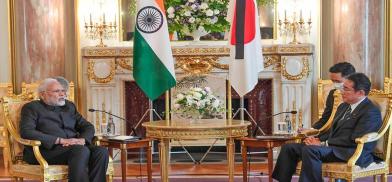‘Ikigai’: Togetherness is the hallmark of expanding India-Japan relations
This partnership is also mutually driven by concerns over China’s territorial and naval expansion in its neighbourhood. As India prepares for the Malabar exercise being hosted by Japan this year, the focus should be on providing a stable, secure and prosperous Indo-Pacific.

The ‘Asian Century’ met with a bump this year with the untimely passing away of the "great friend of India" and the "progenitor" of the Indo-Pacific concept, former Japanese Prime Minister Shinzo Abe. The void left by him in global diplomacy may take a while to fill but the show must go on and his legacy should continue. Since 1952, the bilateral relations between India and Japan have been robust and growing steadily.
As we are celebrating its 70th anniversary, the foundation has been firmly laid and it is now up to these two strategic and economic giants, the third and the fifth largest economies of the world, to pave the way forward for the Asian Century. Along with other powers of the Indo-Pacific region, they are in a position to provide network security to the rules-based order through peaceful diplomatic means.
In this context, as Abe-san would have liked, this year will see the beginning of taking our bilateral relations to the next level, with both nations coming together for a combined Malabar naval exercise in Japan to assist each other and forming agendas during the G20 for the next year when India assumes its presidency.
The evolution of India and Japan's diplomatic relations has been dynamic. Having converging interests and concerns, both nations share a similar vision of a free and open Indo-Pacific, which was first highlighted by Abe-san during his visit to India in 2007. He outlined his vision of the ‘confluence of two seas’ (the Indian Ocean and the Pacific Ocean), which has been adopted by various countries of this region, including many in Europe. The quest to attain peace and prosperity in the region following a rules-based aligns with India's and Japan's security narrative.
Indo-Pacific in focus
The defence partnership between both countries could be a catalyst that drives this vision. India’s Strategic and Global Partnership with Japan is a part of its ‘Grand Strategy’ in a post-Cold War world, which is empowered by their shared values of the rule of law, democracy, and prosperity. This partnership is also mutually driven by concerns over China’s territorial and naval expansion in its neighbourhood. As India prepares for the Malabar exercise being hosted by Japan this year, the focus should be on providing a stable, secure and prosperous Indo-Pacific.
Moreover, with India taking over the G20 presidency in December this year, it is the right time to highlight that the future of this relationship should be based on the principles of the ‘ikigai’ (reason for being together). Their deliberate discourse on global climate change, sustainable development goals, quality infrastructure, combating corruption-related issues, infrastructure financing, food security challenges, and reforms in multilateral systems all are in harmony with the vision of Abe-san and, together, they are for peaceful rules-based world order.
Here, it is important to mention that the strategic partnership between India and Japan has largely been driven by their economic complementarity and security cooperation. To realise India’s goal of becoming a 5 trillion dollar economy by 2025, Japan’s Official Development Assistance is playing an instrumental role in advancing mega-infrastructure projects, particularly in modernising connectivity. The infrastructure export policy of Japan perfectly fits with India-led regional initiatives such as the Coalition for Disaster Resilient Infrastructure and the Indo-Pacific Oceans Initiative.
More specifically, Japan’s engagement with infrastructure developments in Northeast India has been relentless. This cooperation is now expanded to capacity-building, people-to-people contact, and skills development. This is largely driven by the fact that the Northeast acts as a gateway to the Indo-Pacific region through its linkages with Southeast India where both India and Japan are strategically invested.
Mutually compatible perspectives
In other areas, India and Japan share Military Technical Cooperation (MTC) that creates an environment of mutual dependence for fostering the transfer of technological expertise while simultaneously enhancing trust-building. This was endorsed by a Joint Statement on India and Japan Vision 2025 which underlines the strategic importance of transferring defence equipment and technology. Through its US-2 amphibian aircraft and Soryu submarines, Japan hopes to support India in modernising its military capabilities and together look towards balancing the Chinese advances in South and East China and the Yellow Sea.
Furthermore, in their joint exercises for counter-terrorism operations, both counties engage to share best practices. The Acquisition and Cross-Servicing Agreement signed by them in 2020 facilitates the sharing of supplies and services by their respective forces.
Economic cooperation is another area where they are working together. Following the legacy and footprints of ‘Abenomics’, India and Japan concluded their first finance dialogue this year which sets the tone for their future cooperation. They exchanged their status on the macroeconomic situation, financial digitalisation and investment environment and affirmed their commitment to work closely with each other.
In short, while celebrating 70 years of diplomatic relations, India and Japan have aligned their mutually compatible perspectives toward a more balanced and secure international order as evidenced by their desire to bring out reforms in the United Nations and its allied organisations. In the coming years, they should be seen once again jointly performing naval exercises, supporting each other at platforms such as the UN Security Council, the G20 and the Quad groupings to name a few.
Coming together of the two ancient civilisations in all spheres of cooperation is essential for peace, security, stability and prosperity in the Indo-Pacific region, and that is imperative for the Asian Century to become a coherent social, economic and political compact.
(The authors are Research Associates at CUTS International, a global public policy think and action tank on trade, regulation and governance. Views are personal. They can be contacted at prh@cuts.org and sme@cuts.org)








Post a Comment